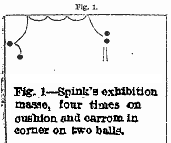1–9
- 1 ball
- Also the 1. The object ball numbered 1; in American-style pool ball sets, it is solid yellow.
- 1-cushion
- See the One-cushion billiards main article.
- 1-pocket
- See the One-pocket main article for the game.
- 2 ball
- Also the 2. The object ball numbered 2; in American-style pool ball sets, it is solid blue. In some American snooker ball sets, the yellow ball is numbered 2, its point value.
- 3 ball
Also the 3. The object ball numbered 3; in American-style pool ball sets, it is solid red. In some American snooker ball sets, the green ball is numbered 3, its point value.
- 3-cushion
- See the Three-cushion billiards main article for the game.
- 4 ball
Also the 4. The object ball numbered 4; in American-style pool ball sets, it is solid purple or rarely pink. In some American snooker ball sets, the brown ball is numbered 4, its point value.
- 5 ball
- Also the 5. The object ball numbered 5; in American-style pool ball sets, it is solid orange. In some American snooker ball sets, the blue ball is numbered 5, its point value.
- 5-pins
- See the Five-pin billiards main article for the formerly Italian, now internationally standardized game; or Danish pin billiards for the five-pin traditional game of Denmark.
- 6 ball
Also the 6. The object ball numbered 6; in American-style pool ball sets, it is solid green. The 6 is the money ball (or game ball) in a game of six-ball. It is the last ball that must be pocketed, after the remaining five object balls have been pocketed, or may be pocketed early to win the game so long as the lowest-numbered ball on the table is struck before the 6. In other games, such as eight-ball, the 6 is simply one of the regular object balls. In some American snooker ball sets, the pink ball is numbered 6, its point value.
- 7 ball
Also the 7. The object ball numbered 7; in American-style pool ball sets, it is solid maroon, brown, or rarely tan. Some variants, for the seven-ball game, are brown with a black or white stripe. The 7 is the money ball (or game ball) in a game of seven-ball. It is the last ball that must be pocketed, after the remaining six object balls have been pocketed, or may be pocketed early to win the game so long as the lowest-numbered ball on the table is struck before the 7. In other games, such as eight-ball, the 7 is simply one of the regular object balls. In some American snooker ball sets, the black ball is numbered 7, its point value.
- 8 ball

An 8 ball (with the cue ball behind it) Also the 8. The object ball numbered 8; in both American- and British-style pool ball sets, it is solid black, though some of the latter use an unnumbered black ball. The 8 is the money ball (or game ball) in a game of eight-ball and related games. It is the last ball that must be pocketed, after the suit of seven object balls belonging to the player who is shooting for the 8. (Pocketing the 8 early is a loss of game—unless done on the break shot, in most rules variants.) In other games, such as nine-ball and straight pool, the 8 is simply another object ball. Due to its striking colouration and regular use as a money ball, it is commonly used as a symbol in popular culture.
- 9 ball
Also the 9. The object ball numbered 9; in American-style pool ball sets, it is striped yellow. The 9 is the money ball (or game ball) in a game of nine-ball. It is the last ball that must be pocketed, after the remaining eight object balls have been pocketed, or may be pocketed early to win the game so long as the lowest-numbered ball on the table is struck before the 9. In other games, such as eight-ball, the 9 is simply one of the regular object balls.
- 9-pins
- See the Goriziana main article for the game sometimes called nine-pins.
- 10 ball
Also the 10. The object ball numbered 10; in American-style pool ball sets, it is striped blue. The 10 is the money ball (or game ball) in a game of ten-ball. It is the last ball that must be pocketed, after the remaining nine object balls have been pocketed, or may be pocketed early to win the game so long as the lowest-numbered ball on the table is struck before the 10, and the 10 ball and pocket are called. In other games, such as eight-ball, the 10 is simply one of the regular object balls.
- 11 ball
- Also the 11. The object ball numbered 11; in American-style pool ball sets, it is striped red.
- 12 ball
- Also the 12. The object ball numbered 12; in American-style pool ball sets, it is striped purple or rarely pink
- 13 ball
- Also the 13. The object ball numbered 13; in American-style pool ball sets, it is striped orange.
- 14 ball
- Also the 14. The object ball numbered 14; in American-style pool ball sets, it is striped green.
- 15 ball
- Also the 15. The object ball numbered 15; in American-style pool ball sets, it is striped maroon, brown, or rarely tan.
- 16-red clearance
- In snooker, a total clearance in which the break starts with a free ball. The break includes potting a colour ball counting as a red and all 15 reds.



























